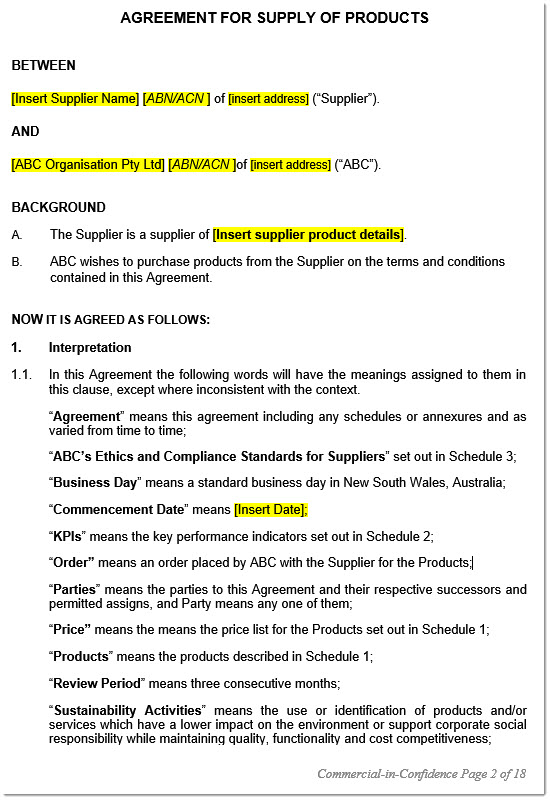In the complex world of trade and commerce, businesses must take essential steps to protect their interests. One such crucial step is establishing a product supply agreement or Agreement for the Supply of Products or Goods. These contracts define the terms under which a supplier will provide products to a buyer, ensuring a smooth and streamlined business process. This comprehensive guide will navigate you through the intricacies of drafting a product supply agreement that lays the foundation for a profitable and long-lasting business relationship.
Understanding the Importance of Product Supply Agreements
Today’s globalised market sees new products introduced every year. These products often pass through international manufacturers, distributors, retailers, or buyers before reaching the consumers. In such a complex business environment, defining each party’s rights and obligations at the onset of a business relationship is crucial for a seamless process.
A product supply agreement is a legally binding contract that outlines the terms and conditions under which a supplier will deliver goods to a buyer. A well-drafted agreement ensures that all parties meet their business and legal requirements in a timely and comprehensive manner.
Key Components of a Product Supply Agreement
Preparing a product supply agreement involves careful drafting to ensure that it accurately captures the intentions of the parties involved. Here are some key components that a comprehensive product supply agreement should include:
1. Parties Involved
The agreement should clearly identify the supplier, who agrees to supply the products, and the buyer, who agrees to purchase them.
2. Term of the Agreement
This section outlines the duration of the agreement. It could be for a specific period or drafted to continue indefinitely.
3. Products to be Supplied
The agreement should contain a detailed list of all products to be supplied by the supplier to the buyer. It is recommended to be specific and include serial numbers or titles if applicable.
4. Quantity of Products
The agreement should specify the minimum quantity of products that the buyer will purchase within a designated time frame.
5. Price and Payment Terms
The agreement should clearly outline the price of the products and the payment terms. For long-term agreements, it may be better to provide for a changing price.
6. Delivery Terms
This section should specify the time, date, and place for product delivery. It should also clarify who is responsible for any damage to, loss of, or delay in providing the products.
7. Warranty Terms
The supplier should provide a warranty that the products will not be defective. In case of defects, the supplier should promise to repair or replace the products.
8. Confidentiality Agreement
The agreement may include a confidentiality clause, requiring the parties to keep any information revealed during the agreement private.
9. Termination of Agreement
The agreement should specify the conditions under which it can be terminated before the end of the term.
10. Governing Law
The agreement should mention the state laws that will be used to interpret the document.
The Process of Drafting a Product Supply Agreement
Creating a product supply agreement involves a systematic and meticulous process. But you can save yourself hours of time and hundreds of dollars in legal fees by starting with our professionally drafted Agreement to Supply Products or Goods Template.
All you have to do is add your personal information to ensure the agreement reflects your situation.

Here is a step-by-step guide to help you complete an effective agreement using our template:
Step 1: Identifying the Parties
Identify the parties involved in the agreement. Each party should be given a name, such as “Supplier” or “Buyer”, to be used throughout the document.
Step 2: Defining the Term of the Agreement
Define the term of the agreement, i.e., the time period during which the products will be supplied. The term should start from the date the agreement becomes effective.
Step 3: Listing the Products
Provide a list of all the items to be supplied by the supplier to the buyer. Ensure that the list is detailed and specific.
Step 4: Specifying the Quantity
Specify the quantity of products that the buyer will purchase within a given time frame. This can be measured in units, weight, volume, cost, etc.
Step 5: Determining the Price and Payment Terms
Determine the price of the products and the payment terms. For long-term agreements, consider providing a changing price.
Step 6: Setting Delivery Terms
Set the terms for product delivery, specifying the time, date, and place. Also, define who will be responsible for any damage to, loss of, or delay in providing the products.
Step 7: Including Warranty Terms
Include a warranty from the supplier that the products will not be defective. If defects are found, the supplier should promise to repair or replace the products.
Step 8: Drafting a Confidentiality Agreement
Draft a confidentiality agreement if required. This will require both parties to keep any information revealed during the agreement private.
Step 9: Setting Termination Conditions
Set the conditions under which the agreement can be terminated before the end of the term.
Step 10: Defining the Governing Law
Define the state laws that will be used to interpret the document.
Buy Product Supply Agreement TemplateConclusion
A product supply agreement is a crucial document that ensures a smooth and efficient business process. It protects the interests of all parties involved and lays the foundation for a profitable and long-lasting business relationship.
Remember, a successful business deal begins with good documentation. A well-drafted product supply agreement will help you navigate the complexities of global trade and commerce.

